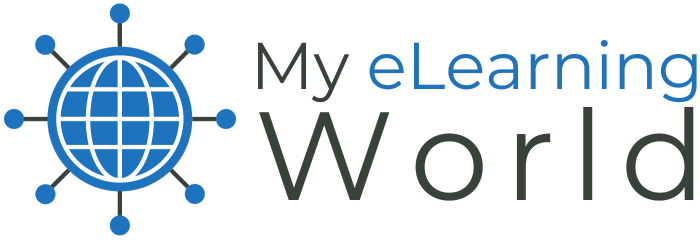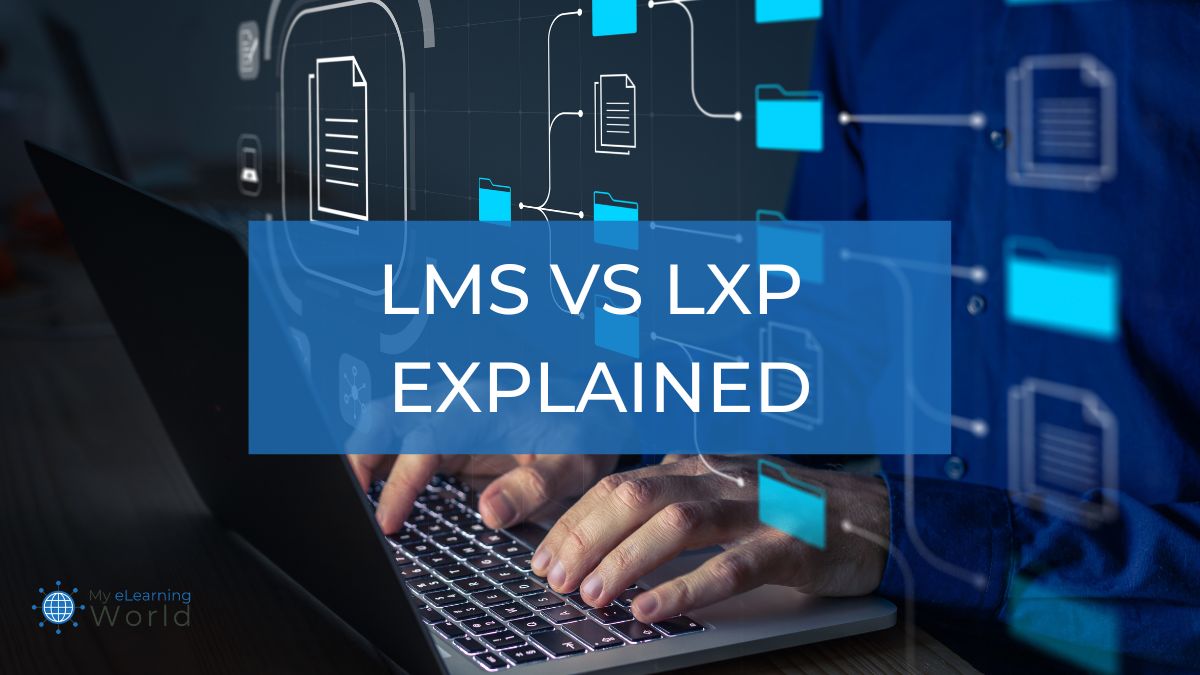As someone who’s been involved with education and eLearning for years now, I can tell you that EdTech has advanced significantly over time, with Learning Management Systems (LMS) and Learning Experience Platforms (LXP) emerging as two prominent solutions. While both contribute to the digital transformation of education, they serve distinct purposes.
In this article, I’m going to explore the key differences between LMS and LXP to help educators make informed decisions based on their unique needs.
LMSs to LXPs
In the “old days”, Learning Management Systems were used to facilitate distance learning. A far cry from the systems of today, these early LMSs had limited options for interactivity beyond discussion forums, and the content provided a linear path through the learning materials.
Remember correspondence courses? Correspondence courses took place through the mail, with the school sending the curriculum to the student. Tests and assignments had to be mailed back to be reviewed or scored.
For the most part, early LMS-based courses followed a “correspondence” model. The LMS course model was, for the most part, a written lecture, maybe a discussion with peers, and essays for exams. Very formulaic and kind of boring.
Fast forward to today and LMSs have grown more powerful and complex, supporting all types of content formats, activities, quizzes, and more. LMSs are the tool of choice for colleges, corporations delivering employee training, and other scenarios that are expected to follow a predictable path through the curriculum.
Learning Experience Platforms were designed to build on this model, adding more advanced technologies to support learning, such as data analytics and the ability to provide individualized learning paths. Perfect for corporate training and skill development, these platforms let learners choose their own adventure.
Let’s look more closely at the benefits of each system.
Learning Management System (LMS)
An LMS is primarily designed for content management, administration, and tracking learner progress. It acts as a centralized hub for organizing, delivering, and managing educational content, assessments, and communication.
Benefits:
- Content Organization and Delivery: LMS platforms excel in efficiently organizing educational content. Educators can structure courses, modules, and lessons, ensuring a seamless delivery of information to learners.
- Administration and Tracking: LMS provides robust administrative tools for managing users, roles, and permissions. It also tracks learner progress, enabling educators to monitor completion rates, assessment scores, and overall engagement.
- Scalability: LMS platforms are scalable, making them suitable for institutions of various sizes. They can accommodate large cohorts of learners and handle extensive content libraries, making them ideal for structured curricula.
- Standardized Assessments: LMS platforms facilitate the creation and management of standardized assessments. From quizzes to exams, educators can deploy assessments and evaluate learner performance systematically.
- Efficiency in Compliance Training: LMS is widely used for compliance training. The linear nature of LMS content ensures that employees complete required training modules and maintain regulatory compliance.
Learning Experience Platform (LXP)
Conversely, an LXP takes a learner-centric approach, emphasizing a more personalized and interactive learning experience. LXPs go beyond content delivery, incorporating social and collaborative features, focusing on the overall learner journey.
Benefits:
- Personalized Learning Paths: LXPs prioritize individualized learning experiences. They allow learners to follow personalized learning paths based on their preferences, interests, and learning styles. This adaptability enhances engagement and understanding.
- Interactive and Engaging Content: LXPs go beyond traditional content delivery. They incorporate interactive elements such as simulations and gamified activities, creating a more engaging and immersive learning experience.
- Social and Collaborative Features: One of the primary strengths of LXPs is their emphasis on social learning. Features like discussion forums, group projects, and collaborative assignments encourage peer-to-peer interaction, fostering a sense of community among learners.
- Holistic Learning Journey: LXPs focus on the overall learning journey rather than isolated courses. Learners can explore diverse topics, access content from various sources, and engage in continuous learning, promoting a holistic approach to education.
- Adaptability to Modern Teaching Methodologies: LXPs are well-suited for modern teaching methodologies, including flipped classrooms and project-based learning. They provide educators with the flexibility to experiment with innovative approaches to instruction.
Key Differences Between LMSs and LXPs
Learning Management Systems (LMS) and Learning Experience Platforms (LXP) offer distinct approaches to facilitate learning. To select the right platform for your organization, you must understand the key differences. Below you’ll find a list of key differences between these two essential learning tools. Top of Form
Content Delivery and Management
- LMS platforms are structured and hierarchical, offering a systematic way to organize and deliver content. They are well-suited for traditional course structures, making them ideal for institutions following a standardized curriculum.
- LXPs prioritize flexibility, allowing for a more dynamic and personalized content delivery. They often curate content from various sources, supporting a broader range of learning materials. This adaptability is particularly beneficial in accommodating diverse learning styles.
Learner-Centric Approach
- LMS platforms are designed with a focus on administration and content delivery. While they track learner progress, their emphasis is on the structured dissemination of information rather than creating a tailored learning experience.
- LXPs prioritize the learner’s experience, providing features such as personalized learning paths, interactive content, and collaborative tools. They recognize and adapt to individual learning styles, fostering a more engaging and dynamic educational journey.
Assessment and Progress Tracking
- LMS platforms excel in traditional assessments and progress tracking. They offer robust tools for creating quizzes, exams, and assignments, allowing educators to monitor and evaluate learner performance systematically.
- While LXPs also support assessments, their approach is often more varied, including alternative methods like project-based evaluations. Additionally, LXPs provide real-time progress tracking, offering a holistic view of a learner’s journey.
Social and Collaborative Features
- LMS platforms may include basic discussion forums or collaboration tools, but their primary focus is on content delivery. Social features are often secondary, with limited emphasis on fostering a collaborative learning community.
- LXPs shine in social and collaborative features, encouraging interaction and engagement among learners. Discussion forums, group projects, and collaborative assignments are integral components, creating a more vibrant and participatory learning environment.
Flexibility and Adaptability
- LMS platforms are well-suited for institutions with a structured curriculum, as they are less adaptable to rapid changes or diverse learning needs. They excel in managing course content within predefined parameters.
- LXPs thrive in dynamic environments, adapting to changes in real-time. Their flexibility is advantageous for organizations embracing new teaching methodologies, accommodating evolving learning needs, and navigating unforeseen challenges.
Implementation in the Classroom
- LMS platforms are commonly integrated into traditional classroom settings, aligning with established teaching methods. They provide structure and efficiency, streamlining content delivery and assessment processes.
- LXPs are particularly beneficial in modern, student-centric classrooms, including virtual or blended learning environments. They empower educators to create engaging and interactive learning experiences, fostering a more inclusive and adaptable classroom culture.
Choosing Between LMS and LXP
Choosing between a Learning Management System (LMS) and a Learning Experience Platform (LXP) requires careful consideration of your organization’s specific needs, goals, and preferences. Here are key questions to ask when making this decision:
What are the Learning Objectives?
- LMS: Is the primary goal to deliver structured content, manage assessments, and track learner progress within a defined curriculum?
- LXP: Is there a focus on creating a personalized and engaging learning experience that goes beyond traditional content delivery?
How Flexible is the Learning Environment?
- LMS: Is a more structured and standardized learning environment suitable, with a focus on compliance and completion of predefined courses?
- LXP: Is flexibility and adaptability important, allowing for personalized learning paths and exploration of diverse topics beyond a rigid curriculum?
What Level of Collaboration is Needed?
- LMS: Is the emphasis on individual progress and assessment, with collaboration being a secondary consideration?
- LXP: Is fostering a collaborative learning community through features like discussion forums, group projects, and social interactions a priority?
What Types of Content Will be Utilized?
- LMS: Is the primary content text-based, with a focus on quizzes, exams, and traditional assessments?
- LXP: Does the content include multimedia elements like videos, simulations, and interactive activities to enhance engagement?
Is Personalization Important?
- LMS: Does the learning environment require customization based on individual learner needs, or is a standardized approach sufficient?
- LXP: Is the goal to provide learners with personalized learning paths, adapting to their preferences, interests, and learning styles?
What is the Preferred Approach to Learning?
- LMS: Is the traditional, instructor-led approach to learning suitable, where content is centrally managed and disseminated?
- LXP: Is there a preference for learner-centric, interactive, and immersive learning experiences that allow exploration beyond predefined courses?
How Important is Real-time Progress Tracking?
- LMS: Is real-time tracking of learner progress and assessments a critical requirement for monitoring and evaluation?
- LXP: Does the focus extend beyond standardized assessments to include real-time tracking of overall learner engagement and interactions?
What is the Institution’s Vision for Education?
- LMS: Does the institution align more with a traditional, structured educational model?
- LXP: Is there a desire to embrace modern teaching methodologies, promote continuous learning, and create an adaptable educational environment?
How Scalable is the Solution?
- LMS: Is scalability crucial for accommodating large cohorts of users and managing extensive content libraries?
- LXP: Is adaptability to changes in learner needs and evolving teaching practices a priority?
What is the Budgetary Consideration?
- LMS: Does the budget align with a solution that prioritizes content management, administration, and standardized assessments?
- LXP: Is the budget conducive to investing in a platform that focuses on a personalized, engaging, and collaborative learning experience?
Final Thoughts
What’s the right tool for your needs? There is no one-size-fits-all solution.
The decision to use an LMS vs. LXP depends on your goals, teaching methodologies, and the adaptability and flexibility you need the platform to have. Both types of platforms have integral roles to play in the future of digital education, offering unique strengths to meet the diverse needs of learners and educators alike.
By carefully considering these questions, you can navigate the decision-making process more effectively and select the platform that aligns best with your educational objectives and preferences.

